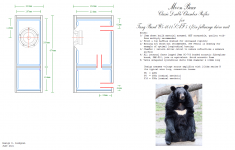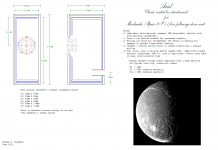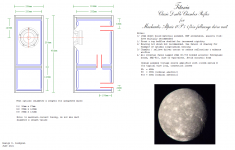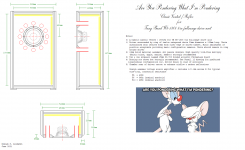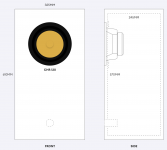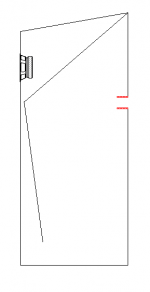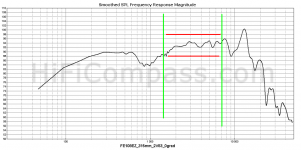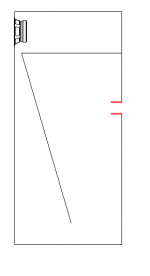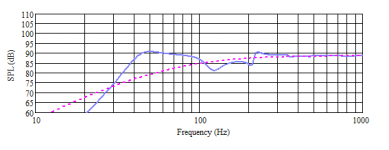...and yes, since I've done 'classic' versions for the other 5 1/4in MA units (CHR90 & 10.3) I might as well do the same for the 10P.
I really should beg Dave's forgiveness for my lousy sketches, but I can't inflict everything on him -especially since he isn't fond of vented enclosures. 😉
I really should beg Dave's forgiveness for my lousy sketches, but I can't inflict everything on him -especially since he isn't fond of vented enclosures. 😉
Attachments
Alright! 🙂 Got some serious vintage 'look' going on now!
Ya know, I never did get around to doing one, though did several small 'FR' speakers like the patent's driver-in-vent variant, though learned about it from the Altec 2000B tweeter, so not just some patent whimsy: http://www.hifilit.com/Altec/1959-j.jpg
Ya know, I never did get around to doing one, though did several small 'FR' speakers like the patent's driver-in-vent variant, though learned about it from the Altec 2000B tweeter, so not just some patent whimsy: http://www.hifilit.com/Altec/1959-j.jpg
Scott, I have built some FHmk3s using Alpair 7MSs, and they're phenomenal - thank you.
My next project is making use of some cabinets that my grandfather had made ~50 years ago. They are beautiful, and I'd like help my father use them for his home (the drivers perished many years ago). I started to investigate a multi-way designs but I'm stricken by the simplicity of FR drivers and want to stay on that path.
The cabinets are approximately 39L with the volume of the driver subtracted, and are not hugely far in stature from the some of the published cabinet designs for the CHR-120, which I can hopefully source through a dealer here in Australia - he only stocks the CHN-110 and 11MS at present.
What do you think? I'm not chasing perfect fidelity; just a simple, enjoyable, easy to drive speaker that can work with what I have. The 120 would be preferable I think, but if it must be the 110/11MS then thoughts on applicability would be much appreciated too.
Thank you in advance!
Edit: I just noticed the cabinet for the FA22RCZ you posted on the first page of this thread - it is almost identical to mine! I will continue trawling the thread pages...
My next project is making use of some cabinets that my grandfather had made ~50 years ago. They are beautiful, and I'd like help my father use them for his home (the drivers perished many years ago). I started to investigate a multi-way designs but I'm stricken by the simplicity of FR drivers and want to stay on that path.
The cabinets are approximately 39L with the volume of the driver subtracted, and are not hugely far in stature from the some of the published cabinet designs for the CHR-120, which I can hopefully source through a dealer here in Australia - he only stocks the CHN-110 and 11MS at present.
What do you think? I'm not chasing perfect fidelity; just a simple, enjoyable, easy to drive speaker that can work with what I have. The 120 would be preferable I think, but if it must be the 110/11MS then thoughts on applicability would be much appreciated too.
Thank you in advance!
Edit: I just noticed the cabinet for the FA22RCZ you posted on the first page of this thread - it is almost identical to mine! I will continue trawling the thread pages...
Attachments
Last edited:
Thanks Dave. I am also attracted to the 12P... I've asked the dealer if he has stock as it's on his site. Interested to know if there are any experiences with it...
Alright! 🙂 Got some serious vintage 'look' going on now!
It has to be done every now & then. 😉 TBH, I really like this one. I wish there were a few more current drivers with the Vb requirements that make it practical. Still, a few to be going on with...
Ya know, I never did get around to doing one, though did several small 'FR' speakers like the patent's driver-in-vent variant, though learned about it from the Altec 2000B tweeter, so not just some patent whimsy: http://www.hifilit.com/Altec/1959-j.jpg
That / the d-in-v were genius. The industry seems uncommonly good at chucking good things away.
Scott, I have built some FHmk3s using Alpair 7MSs, and they're phenomenal - thank you.
My next project is making use of some cabinets that my grandfather had made ~50 years ago. They are beautiful, and I'd like help my father use them for his home (the drivers perished many years ago). I started to investigate a multi-way designs but I'm stricken by the simplicity of FR drivers and want to stay on that path.
The cabinets are approximately 39L with the volume of the driver subtracted, and are not hugely far in stature from the some of the published cabinet designs for the CHR-120, which I can hopefully source through a dealer here in Australia - he only stocks the CHN-110 and 11MS at present.
CHR120 will work. CHN110 will go in with a bit of work, as Dave says, although dynamic range will be reduced for obvious reasons. The 12P won't be ideal 'as is' although with a bit more work (namely about 3.3ohms series R) it will go in, at the price of reduced sensitivity. There isn't actually anything wrong with that, providing it's done for a specific purpose, with eyes wide open and appropriate measures taken.
Thanks Dave. I am also attracted to the 12P... I've asked the dealer if he has stock as it's on his site. Interested to know if there are any experiences with it...
For that size box you’d need 2 x A12p. A12pw would work.
dave
Right, the 12P is not a 'natural' ideal in that volume. 😉 As I say, you can make it work with about 3.3ohms series R, providing you address the power handling & heat dissipation, since you're dropping system efficiency; reference conversion efficiency η0 will drop from roughly 0.9431% to 0.64% and SPL from 92.343dB 1m/2.83v to 90.664dB 1m/2.83v (based on the published spec.)
Thanks Scott and Dave! I will try my best to source the CHR-120. If I can't get it locally I'll buy from KJF [the shipping to Aus is more than one of the drivers 😱]
I noted that the CHR-120 vented box designs list "Series 1/2ohm series resistance" - will I need to place a series resistor in before the driver, or is this referring to the inherent resistance of speaker wiring?
Last curious questions...
1. What are the result(s) of having two or even three vents instead of one?
2. Shall I follow the approximate driver placement in your designs? I presume it is derived from avoiding any internal walls of equal length...
3. I am replacing the front baffle but would like to reuse the current speaker grills. The CHR-120 has an Xmax of 9mm - would insetting the driver ~10mm in to the baffle with a bevel affect the diffraction noticably?
I noted that the CHR-120 vented box designs list "Series 1/2ohm series resistance" - will I need to place a series resistor in before the driver, or is this referring to the inherent resistance of speaker wiring?
Last curious questions...
1. What are the result(s) of having two or even three vents instead of one?
2. Shall I follow the approximate driver placement in your designs? I presume it is derived from avoiding any internal walls of equal length...
3. I am replacing the front baffle but would like to reuse the current speaker grills. The CHR-120 has an Xmax of 9mm - would insetting the driver ~10mm in to the baffle with a bevel affect the diffraction noticably?
Attachments
Last edited:
No, it just means I've incorporated 1/2ohm series R into the alignment to account for wire loop, connections &c.
Re the others, in the same order:
1/ For the same total CSA, it will add some frictional losses, i.e. for the same vent area, the greater the number of vents, the less efficiently they'll work. This is relative / a matter of degree and dependent upon size & aspect ratio -in many cases, the losses are insufficient to have any significant audible effect, so we're in the realms of technicalities. However it can happen: Dave for instance deliberately exploits this effect with his fonken et al designs.
2/ Assuming the box dimensions in question are those in your post above, I'd be inclined to centre the driver 245mm down from the internal top.
3/ Depends what you call 'noticably'. If you don't have an equivalent sans inset, then you've no baseline for comparison. 😉 Yes, it will have an effect, but providing you put a reasonable bevel on it, it's unlikely to cause massive problems -ultimately you pick your compromises according to what is required for practical purposes, so I wouldn't lose much sleep over it.
Re the others, in the same order:
1/ For the same total CSA, it will add some frictional losses, i.e. for the same vent area, the greater the number of vents, the less efficiently they'll work. This is relative / a matter of degree and dependent upon size & aspect ratio -in many cases, the losses are insufficient to have any significant audible effect, so we're in the realms of technicalities. However it can happen: Dave for instance deliberately exploits this effect with his fonken et al designs.
2/ Assuming the box dimensions in question are those in your post above, I'd be inclined to centre the driver 245mm down from the internal top.
3/ Depends what you call 'noticably'. If you don't have an equivalent sans inset, then you've no baseline for comparison. 😉 Yes, it will have an effect, but providing you put a reasonable bevel on it, it's unlikely to cause massive problems -ultimately you pick your compromises according to what is required for practical purposes, so I wouldn't lose much sleep over it.
Last edited:
Again, all is hugely appreciated Scott - that clears up a lot. The cabinet shape posted is indeed the one I plan on using. I’ll be sure to follow up with results!
Hey Scott,
Since you are such an expert on speaker design, could you figure out what they were doing in this one....
"Anything below is created by sympathetic vibrations of the speaker load. The transducer couples directly to the enclosure air which comprises two Helmholtz chambers connected via a truncated folded horn, the second chamber being also open to the outside via a tuned port. The mass of air put to motion then equals the mass of the membrane plus the mass of the air in the two cavities to result in an equivalent much larger membrane. The key to the design is that when air pressure is maximum at the port, it is minimum behind the membrane. This enables higher bass playback volumes with minimal excursion from the driver."
6moons audioreviews: Finale Vivace Mini
Oon
Since you are such an expert on speaker design, could you figure out what they were doing in this one....
"Anything below is created by sympathetic vibrations of the speaker load. The transducer couples directly to the enclosure air which comprises two Helmholtz chambers connected via a truncated folded horn, the second chamber being also open to the outside via a tuned port. The mass of air put to motion then equals the mass of the membrane plus the mass of the air in the two cavities to result in an equivalent much larger membrane. The key to the design is that when air pressure is maximum at the port, it is minimum behind the membrane. This enables higher bass playback volumes with minimal excursion from the driver."
6moons audioreviews: Finale Vivace Mini
Oon
Well, I would make clear that I am not an expert, and having spent the majority of my adult life in or closely connected to academia, I also maintain that anybody who describes themselves as an expert in any subject is not one. 😉
With that first said, ejecting the verbiage (which sounds uncommonly like a bowlderised variation of basic bass reflex operation), it appears to be descended from an obscure box released by the defunct Gemme Audio's equally defunct sister company, and a lash-up modification they made to it to correct some of its more glaring problems. Basically, reading between the lines, a chambered bass horn, mass-loaded with a vent. I would surmise the first of the two 'Helmholtz chambers' referred to is the driver chamber; the second may be an addition, or if the original is anything to go by, may simply be referring to the rear half of the box, if the internal folding scheme does not produce any kind of consistent expansion ratio, a bit like the attached.
With that first said, ejecting the verbiage (which sounds uncommonly like a bowlderised variation of basic bass reflex operation), it appears to be descended from an obscure box released by the defunct Gemme Audio's equally defunct sister company, and a lash-up modification they made to it to correct some of its more glaring problems. Basically, reading between the lines, a chambered bass horn, mass-loaded with a vent. I would surmise the first of the two 'Helmholtz chambers' referred to is the driver chamber; the second may be an addition, or if the original is anything to go by, may simply be referring to the rear half of the box, if the internal folding scheme does not produce any kind of consistent expansion ratio, a bit like the attached.
Attachments
Last edited:
OK I don't set myself up for Solomon, and I do not wish to pursue this any further after this post as it's not the purpose of this thread. However, I had a moment so I thought I'd take a quick gander at what was said in the 6moons review of the Vivace Mini, which confirmed it was following roughly the configuration of its predecessor, the Vivace. The latter was measured by Paul Messenger as part of his own review elsewhere some years ago, and it contains a couple of salient comments.
Firstly: 'Perhaps the most unusual feature is the strong and seamlessly flat output through the presence and lower treble (1.5-7kHz), and this was very audible indeed'.
We can get some confirmation of this easily enough: the original Vivace ran the FE108ESigma, and the description is indeed is consistent with other measures of that drive unit, as can be seen in the attached, courtesy of HFC. I've highlighted the region Paul notes.
Next: 'The frequency response is far from flat, showing significant -7dB suckouts at 1kHz and 10kHz'
Again, all consistent with other measures of that drive unit, suggesting Paul's descriptions of the response can be relied upon to a reasonable extent. Which isn't surprising -Paul is good at this, and extremely experienced, so it's what I'd expect. However, 'In God we trust, everyone else we verify'. 😉 Hence the check, now done.
Finally: '...the actual net bass energy was pretty well maintained down to 35Hz or so, but output was rather too strong 45-80Hz, and too weak 110-200Hz'
This sounds familiar enough for a quick theoretical experiment: I took a simplified rectangular box, driver in an upper chamber, with a single folded horn below with mass-loading duct per the sketch attached. The modelled LF response of this simplified box is indicated is also attached. I didn't bother doing any refinements as it seems to have enough consistency with the description to suggest the Vivace variations are likely to be something roughly along the lines of what is in this & the post above.
Firstly: 'Perhaps the most unusual feature is the strong and seamlessly flat output through the presence and lower treble (1.5-7kHz), and this was very audible indeed'.
We can get some confirmation of this easily enough: the original Vivace ran the FE108ESigma, and the description is indeed is consistent with other measures of that drive unit, as can be seen in the attached, courtesy of HFC. I've highlighted the region Paul notes.
Next: 'The frequency response is far from flat, showing significant -7dB suckouts at 1kHz and 10kHz'
Again, all consistent with other measures of that drive unit, suggesting Paul's descriptions of the response can be relied upon to a reasonable extent. Which isn't surprising -Paul is good at this, and extremely experienced, so it's what I'd expect. However, 'In God we trust, everyone else we verify'. 😉 Hence the check, now done.
Finally: '...the actual net bass energy was pretty well maintained down to 35Hz or so, but output was rather too strong 45-80Hz, and too weak 110-200Hz'
This sounds familiar enough for a quick theoretical experiment: I took a simplified rectangular box, driver in an upper chamber, with a single folded horn below with mass-loading duct per the sketch attached. The modelled LF response of this simplified box is indicated is also attached. I didn't bother doing any refinements as it seems to have enough consistency with the description to suggest the Vivace variations are likely to be something roughly along the lines of what is in this & the post above.
Attachments
Last edited:
Well, I am a very big expert in understanding women.... but nobody seems to believe me .... including my wife.... oh well...Well, I would make clear that I am not an expert, and having spent the majority of my adult life in or closely connected to academia, I also maintain that anybody who describes themselves as an expert in any subject is not one. 😉
With that first said, ejecting the verbiage (which sounds uncommonly like a bowlderised variation of basic bass reflex operation), it appears to be descended from an obscure box released by the defunct Gemme Audio's equally defunct sister company, and a lash-up modification they made to it to correct some of its more glaring problems. Basically, reading between the lines, a chambered bass horn, mass-loaded with a vent. I would surmise the first of the two 'Helmholtz chambers' referred to is the driver chamber; the second may be an addition, or if the original is anything to go by, may simply be referring to the rear half of the box, if the internal folding scheme does not produce any kind of consistent expansion ratio, a bit like the attached.
So if I understand it correctly. It starts a bass reflex, the output of the port is a high velocity airstream so it makes sense to put it through a horn. The output of the horn is then fed through a second bass reflex where the mouth of the horn serves as a speaker driver. For the second bass reflex the port connects to the outside. Would that be a correct description of how it works?
What is the advantage of this system? Does it give a very large boost? or better power handling by reducing cone excursion over a wide range of frequency?
Let's just say if you wanted to design a cabinet for a 3" Faitalpro 3fe22 with an decent bass response how would you have done it?
Oon
I would suggest forgetting the bass reflex verbiage. Remember, it's a commercial product & they're trying to make it sound impressive. 😉 Assuming it's akin to the above, it's simply a chambered back-horn with the terminus choked down, aka mass-loaded, with a duct. In that sense it's basically akin to mass loading a regular chamberless Voigt / expanding pipe -it just happens to have the driver in its own chamber, which notionally decouples it / forms an acoustic low-pass filter, although how effective that is will rather depend on the details of implementation & circumstances.
Last edited:
- Home
- Loudspeakers
- Full Range
- Miscellaneous designs - Markaudio, Fostex, TB, Dayton, SEAS etc
